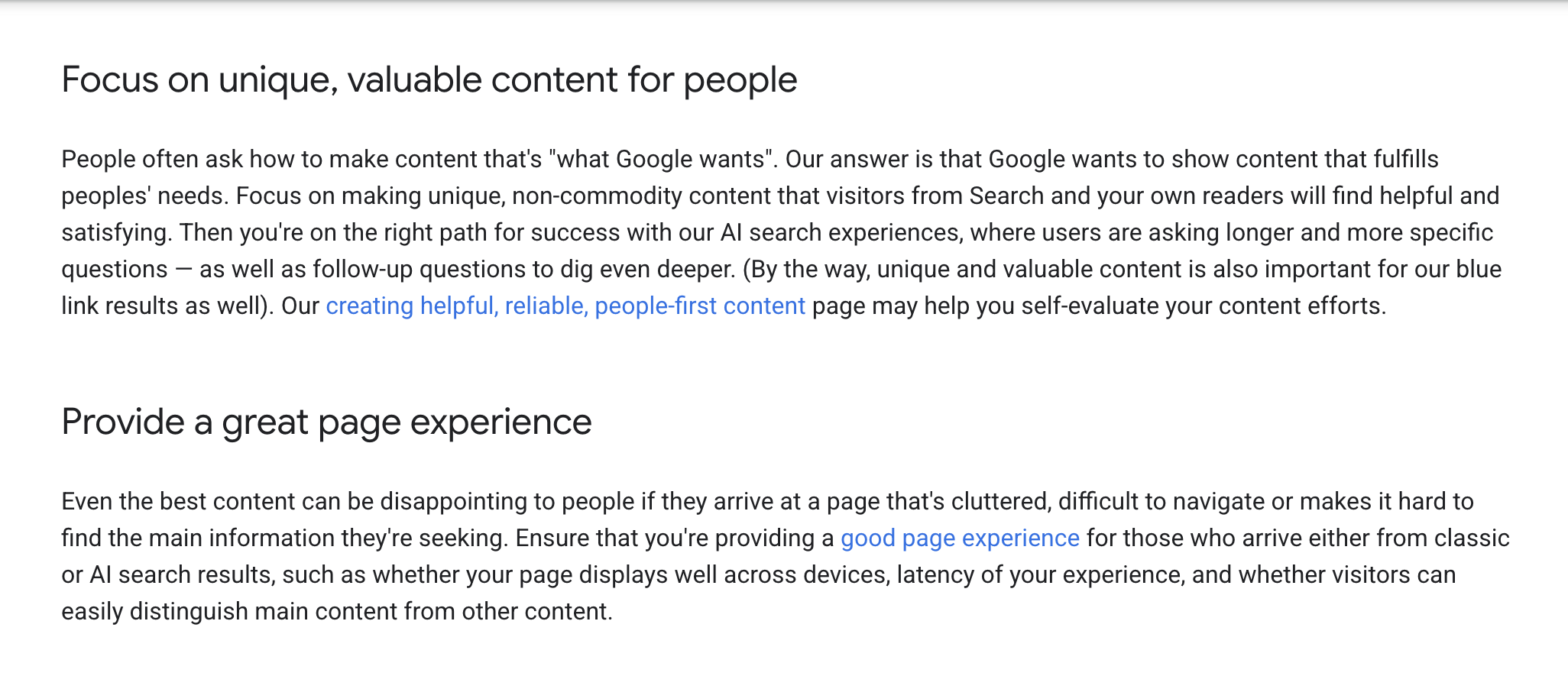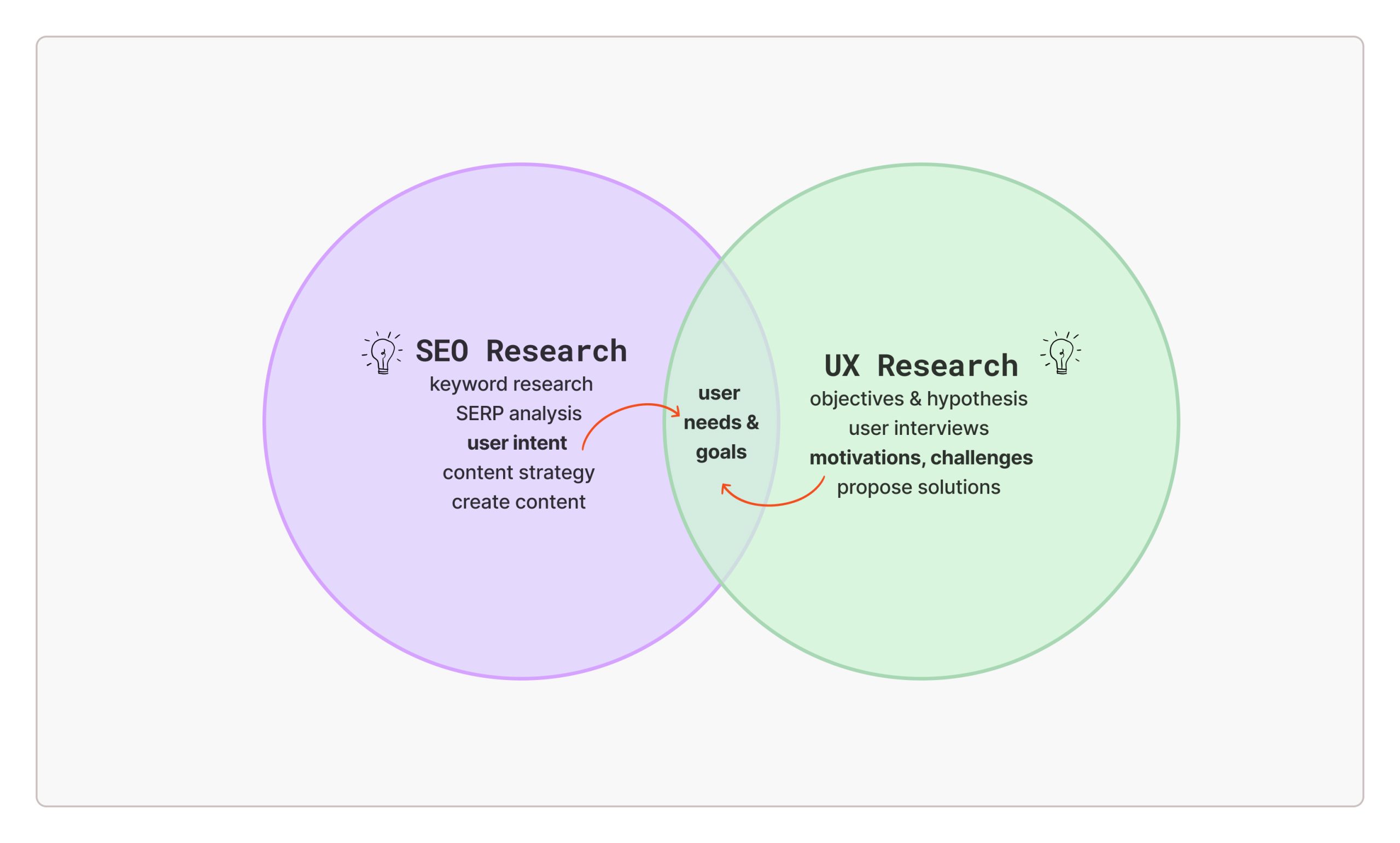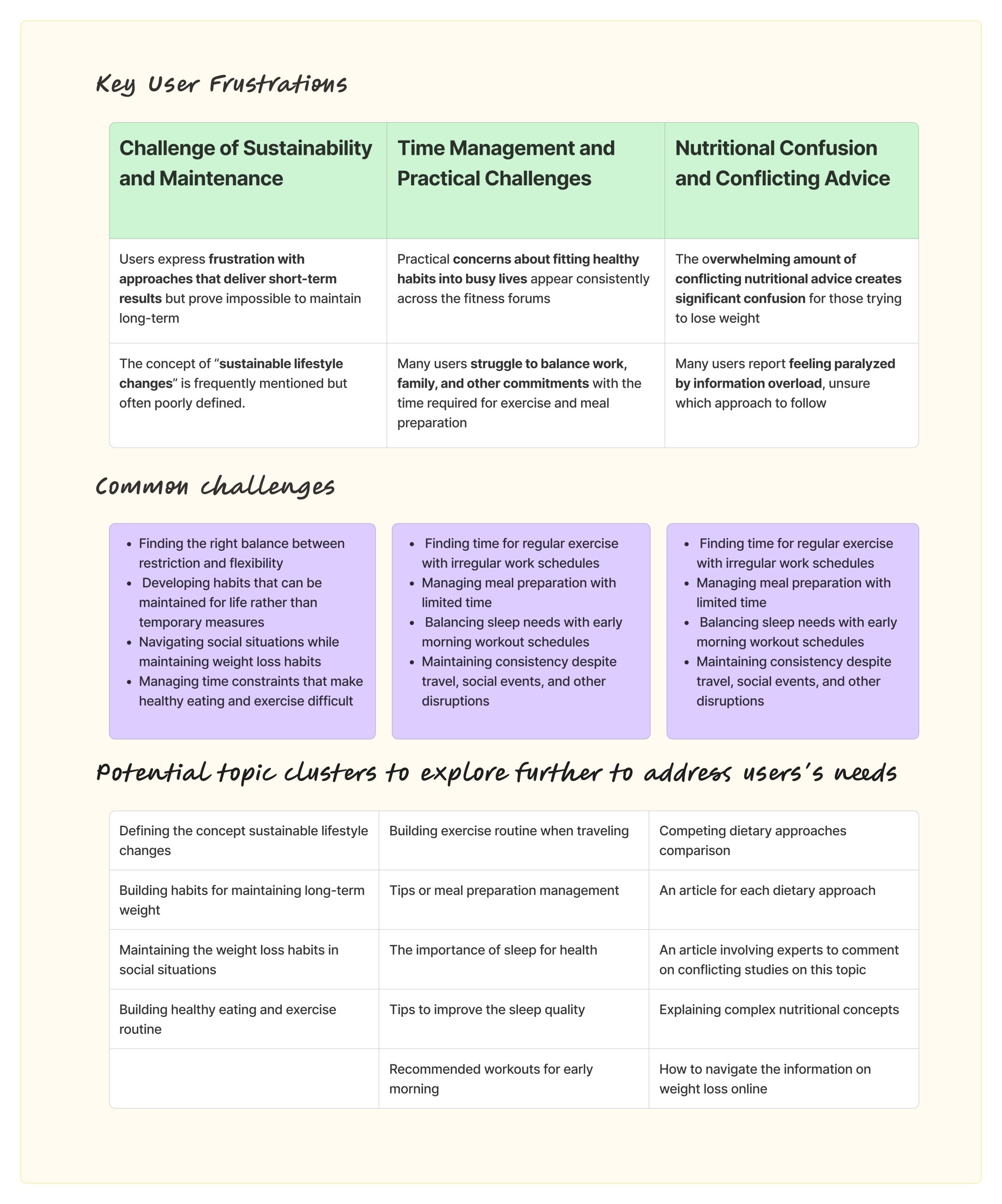Blending SEO & UX to Build Content for Real People
People-First Content: Why It Matters in the Era of AI?
As AI-driven and conversational search transforms how users discover content, creating helpful, people-first content is essential.
In this new landscape, we shouldn’t be talking about content creation for SEO, GEO, or AIO. Instead, we should focus on creating content that genuinely serves people.
At the heart of today’s most effective SEO strategies lies brand authority— which can only be earned through high-quality content and user satisfaction.
This is where SEO and UX blend. While SEO helps us understand what people are searching for, UX reveals what drives their interests and why they behave the way they do. Together, they form the foundation for truly user-centered content strategies.
The synergy between SEO and UX offers a powerful framework for understanding not just what users search for, but what drives their online behaviour and needs.
People-First Content is Not New
It’s worth noting that people-first content is not something new. Google has been advocating for real people oriented content since a while ago. Core updates, E‑E-A‑T, Helpful Content Updates were all launched with the goal to secure useful content in the search results.
With the appearance of AI Agents and the announcement of the AI Mode, this message is reinforced.
Google’s recommendation on how to perform well in the AI-powered search results:

How SEO and UX Can Work Together to Build Smarter Content Strategies
🔍 SEO Reveals What & How People Search
SEO revolves around understanding what people search for:
- Which keywords they use when search,
- Which questions they ask,
- What kind of content ranks well.
By analyzing keyword trends, SERP features like “People Also Ask,” and competitor content, SEO provides a data-driven map of user intent.
However, SEO alone does not answer why users behave the way they do and what emotional drivers shape their behaviour online.
💬 UX Answers Why People Behave the Way They Do
To understand the real reason behind user behaviour more in depth, we can complement the SEO analyses with more exhaustive research, such as UX research.
UX research adds a human layer to keyword data, uncovering users’ motivations, frustrations, and needs. Combining SEO and UX helps us empathize with our audience and design content that truly serves them.
While SEO provides valuable insights into search patterns and user intent through keyword research and SERP analysis, UX research methodologies—including in-depth interviews, surveys, and online forum analysis—reveal the deeper motivations, frustrations, and needs that drive user behaviour.
SEO and UX in a Unified Framework
How UX Complements SEO in Content Strategy?
- UX research uncovers deeper needs and motivations: Insights from interviews, surveys, or user feedback can complement keyword research and help scope more conversational queries.
- Informing more natural, conversational content: UX insights help expand keyword targeting to match real-life user questions and phrasing.
- Creating key user personas: Allows understanding different types of users and tailoring content to address their needs in different ways.
- Structuring content for real people: Many UX principles can enrich SEO by guiding on how to create user oriented pages.

UX Research Methods That Elevate SEO Strategy
UX research is a perfect tool for creating user-centered content strategies. It gives us a deep dive into the why behind user behaviour. UX research provides insight into users’ motivations, needs and behaviour, which is something that can perfectly complement our SEO strategy.
Connecting SEO with UX research isn’t just about improving search rankings or user experience metrics—it’s about creating content that genuinely serves people’s needs.
Here are key UX research methods you can use to enrich your SEO strategy:
🎤 In-Depth User Interviews
In-depth interviews are a great way to learn more about your users. The user is asked exploratory, open questions allowing a deep dive into their behaviours, frustrations, expectations and aspirations when it comes to certain products or services.
What you can learn:
- What users like or dislike about a certain topic.
- Their emotional triggers, motivations, and pain points.
- The main fears, challenges or doubts.
- What drives users’ actions and online behaviour.
UX researchers usually ask the user about their routine, about the way they use a product or service, about the challenges but also ideas on how to improve. The asked questions are open-ended and there is enough space for the user to express themselves and their feelings.
Organising Layout and Content Structure
Insights from UX research can help us organise the layout and the content on our pages based on the on what really is important for our users.
💡 Example:
In a project aimed at improving the online shopping experience for an e‑commerce site, in-depth interviews provided valuable insights for improving the content structure on the product detail pages (PDP).
The interviews with users showed:
- Users like their online shopping experience to feel safe and mirror a real life visit to a clothing store, while they shop comfortably form their sofa.
- They appreciate transparency and realistic representation of products and are frustrated if misled in terms of sizes, costs and shipping times.
- Many users mentioned trust issues when buying clothing online.
- Users are frustrated about the fact they can make a mistake when shopping online and have to return the product, thus appreciate feeling like they have enough information to make a decision they won’t regret later.
Based on these insights, the content structure on the PDP can be significantly improved, organising content and layout in a way we can address the pain points and make the user feel safe, build trust and avoid frustrations:
- Transparent and detailed information about the product, shipping times and cost.
- Videos and images that showcase real people using the product.
- User-friendly size charts and information on the fabric and fabric care.
- Transparency about the product availability.
- Any information that is relevant for the user and will grab there attention when it comes to our product.

The UX research outlined multiple ways in which the content on the product detail pages (PDPs) should be created and structured to provide a satisfying experience for the users. Blending this information with SEO surely would result in an high-converting PDP that truly meets user expectations, providing all the information they need in order to make a purchase and feeling confident about it.
📊 Surveys and Online Polls
Surveys and online polls are a great way to ask questions and get public opinion on different topics of interest. Online platforms such as Discord, Reddit or Facebook Groups are perfect for conducting this kind of research.
Another effective way of distributing surveys and asking questions are Newsletters. You can offer different benefits, such as discounts or presents to your users to motivate them to answer your questions. This is a great way of getting valuable feedback and content ideas.
What you can uncover:
- Common questions or concerns users have.
- General opinion about a topic.
- Key information gaps when it comes to a certain topic.
- User expectations around product or service.
More Human User Personas & Their Needs
Different users may search for the same query and have different needs. These needs will be defined by social, political, cultural and other environmental factors that shape their behaviour and the decision making process when search.
For this reason, understanding our different user personas is essential to be able to address their specific needs.
👥 Getting to know your User Personas
UX research and insights from real users enable us define key user personas in detail, understanding their:
- Search behaviour and habits,
- Tech comfort and device usage,
- Pain points, goals, and motivations,
- Challenges and frustrations.
Understanding the key user personas types will enable you to create content strategies for each one of them, addressing their specific needs and motivations.
For example, if we are a clothing brand, and one of our user personas loves shopping, but is also environmentally aware, addressing environment and sustainability related topics might help us build empathy and connection with this user persona type.
If one of our user personas is inpatient and exclusively uses mobile devices for online shopping, this will highlight how important it will be to put effort into Core Web Vitals and mobile responsiveness.
Learning about your different users and their needs is essential for building a user-driven content strategy and ensuring good user experience. UX research is an excellent tool for achieving this.
💻 Online Forums Analysis (with AI)
Online Forums analysis involves reviewing the content across different forum discussions, providing insights into questions users commonly ask, trends, sentiment and shared information.
Forums like Reddit, Quora, and niche communities offer a goldmine of unfiltered user opinions and questions.
This type of analysis can be time-consuming. Luckily, we now have AI to help out. However, always double check the results. This involves some manual work, but, it is necessary when using any of the LLMs.
This is a great way of setting the base for further keyword and user intent research, offering an insight into a broader picture to inform our content strategy. It can be particularly handy if you are short on resources.
What to analyse:
- Commonly asked questions about a topic in your niche.
- Main frustrations users express regarding relevant topics.
- Commonly described challenges users face.
- Emotional tone and vocabulary they use.
Informing Keyword Research & Content Strategies
Insights from user research can be very helpful for the SEO team before conducting keyword research, as this information helps establish the key areas we should address in our content strategy.
💡 Example:
In a project focused on defining a content strategy for a weight loss app AI was used to analyse niche related forums and Reddit to get answers on what users are discussing online regarding weight loss.

This analysis helped identify key user frustrations, common challenges, and provide content suggestions to address them.
Key frustrations:
- Users are worried about sustainability and maintaining a diet long-term.
- There is a general concern about fitting healthy habits into a fast-paced lifestyle.
- Conflicting nutritional advice overwhelms and confuses the users.
Creating a board where key user frustrations and challenges are listed is a great way to identify potential topics to address.

These insights tell us that users worry and are afraid of failure of not being able to achieve their ideal weight and fitness goals. This is a very important point to have in mind when creating the content strategy.
Learning about these insights represents a great base for further keyword research and SERP analysis, which altogether result in a user-centric content strategy.
🛠️ SEO & UX Tools to Support UX-Driven Content Strategy
To fully blend SEO and UX into a cohesive content strategy, the right tools on both sides are essential:
Ahrefs, SEMrush: keyword trends, search volumes, search intent, competitor data.
Google Search Console: user queries and performance.
AlsoAsked and AnswerThePublic: conversational and long-tail questions users are asking.
FigJam, Miro: brainstorm and design user interviews
GoogleMeet, Zoom: conducting interviews online
Hotjar, Maze: tracking user behaviour, conducting interviews
Final Thoughts
As we navigate the evolving AI-driven search landscape and conversational interfaces, the message is clear: content creation must prioritize real people over search algorithms.
The synergy between SEO and UX offers a powerful framework for understanding not just what users search for, but why they behave the way they do.
While SEO provides valuable insights into search patterns and user intent through keyword research and SERP analysis, UX research methodologies—including in-depth interviews, surveys, and online forum analysis—reveal the deeper motivations, frustrations, and needs that drive user behaviour.
This combined approach enables content creators to move beyond surface-level optimization toward building genuine brand authority through quality content that delivers user satisfaction.
By developing detailed user personas and understanding diverse audience needs, brands can create content strategies that address specific challenges while building empathy and connection with their users.
Connecting SEO with UX research isn’t just about improving search rankings or user experience metrics—it’s about creating content that genuinely serves people’s needs.
Leave a Reply